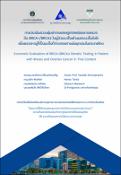บทคัดย่อ
โรคมะเร็งเต้านมและมะเร็งรังไข่เป็นโรคที่พบได้บ่อยในเพศหญิง ในประเทศไทยมะเร็งเต้านมเป็นโรคที่มีอุบัติการณ์การเกิดมากที่สุดในเพศหญิง ส่วนโรคมะเร็งรังไข่พบได้เป็นอันดับ 6 โรคมะเร็งส่วนหนึ่งที่เกิดจากการถ่ายทอดทางพันธุกรรมจะมีโอกาสคาดการณ์ความเสี่ยงในการเกิดโรคได้ โดยกลุ่มผู้ที่มีการกลายพันธุ์ของยีน BRCA1/BRCA2 จะมีโอกาสเป็นมะเร็งเต้านม (ร้อยละ 80) และมะเร็งรังไข่ (ร้อยละ 15-40) สูงกว่าประชากรปกติที่มีโอกาสเกิดมะเร็งเต้านม ร้อยละ 12 และมะเร็งรังไข่ ร้อยละ 1.4 ปัจจุบันมีการตรวจทางอณูพันธุศาสตร์ในผู้ป่วยกลุ่มเสี่ยง เพื่อค้นหาผู้ที่มีความผิดปกติของยีน BRCA1/BRCA2 และสมาชิกในครอบครัวที่มีความเสี่ยงในการเกิดมะเร็งเต้านมและมะเร็งรังไข่ ซึ่งสามารถให้การดูแลรักษาที่เหมาะสม เพื่อป้องกันการเกิดมะเร็งในอนาคต ทำให้สามารถลดอัตราการตายและการเจ็บป่วยของผู้ป่วยกลุ่มนี้ลงได้อย่างมีนัยสำคัญ แต่ปัจจุบันการตรวจเพื่อวินิจฉัยความผิดปกติของยีนมีราคาสูงและไม่รวมอยู่ในชุดสิทธิประโยชน์ ทำให้ผู้ป่วยสิทธิประกันสังคมและสิทธิประกันสุขภาพถ้วนหน้ายังไม่สามารถเข้าถึงการตรวจนี้ได้ วิธีการศึกษา: วัตถุประสงค์ของการศึกษานี้เพื่อประเมินต้นทุนอรรถประโยชน์ของการตรวจยีน BRCA1/BRCA2 เพื่อการวินิจฉัยทางพันธุกรรมสำหรับมะเร็งเต้านมและมะเร็งรังไข่ที่ถ่ายทอดทางพันธุกรรมและได้รับการป้องกันการเกิดโรคมะเร็งเปรียบเทียบกับการไม่ตรวจในบริบทของประเทศไทย โดยทำทั้งในกลุ่มผู้ป่วยมะเร็งเต้านมที่อยู่ในกลุ่มความเสี่ยงสูงที่ควรได้รับการตรวจยีน BRCA1/BRCA2 และกลุ่มญาติสายตรงของผู้ที่ตรวจพบการกลายพันธุ์ของยีน และประเมินผลกระทบด้านงบประมาณหากนำมาพิจารณาบรรจุอยู่ในชุดสิทธิประโยชน์ภายใต้ระบบหลักประกันสุขภาพแห่งชาติโดยใช้แบบจำลองมาร์คอฟ ทำการวิเคราะห์ต้นทุนและผลลัพธ์ทางสุขภาพตลอดชีวิตในมุมมองทางสังคมและมุมมองของรัฐบาล ต้นทุนที่ศึกษาเป็นต้นทุนทางตรงที่เกี่ยวกับการแพทย์และไม่เกี่ยวกับการแพทย์ ผลลัพธ์ทางสุขภาพ ได้แก่ ปีสุขภาวะของผู้ป่วย ผลการศึกษานำเสนอในรูปอัตราส่วนต้นทุนประสิทธิผลส่วนเพิ่ม (Incremental Cost-effectiveness Ratio, ICER) ทำการประเมินผลกระทบของความไม่แน่นอนของตัวแปรที่ใช้ในแบบจำลองโดยวิธีการวิเคราะห์ความไวแบบทางเดียวและแบบอาศัยความน่าจะเป็น ผลการศึกษานี้พบว่าทางเลือกของการตรวจยีนและได้รับการป้องกันการเกิดโรคมะเร็งเป็นทางเลือกที่มีความคุ้มค่าในบริบทของประเทศไทย ทั้งในกลุ่มผู้ป่วยมะเร็งเต้านมที่มีความเสี่ยงสูงที่ควรได้รับการตรวจยีน BRCA1/BRCA2 เมื่อเทียบกับการไม่มีการตรวจยีน โดยมีอัตราส่วนต้นทุนประสิทธิผลส่วนเพิ่ม เท่ากับ 18,591 บาทต่อปีสุขภาวะ และสำหรับกลุ่มญาติสายตรงของผู้ที่ตรวจพบการกลายพันธุ์ของยีนสามารถประหยัดต้นทุนได้ (cost-saving) นอกจากนี้ถ้าพิจารณาในราคาการตรวจยีน BRCA1/BRCA2 ในผู้ป่วยกลุ่มเสี่ยงปัจจุบัน (21,340 บาท) การตรวจยีนและได้รับการป้องกันการเกิดมะเร็งจะมีผลกระทบทางงบประมาณรวม 5 ปี มากกว่าการไม่ได้ตรวจยีน 1,011 ล้านบาท ข้อเสนอเชิงนโยบาย : เสนอให้การตรวจยีน BRCA1/BRCA2 ในกลุ่มผู้ป่วยมะเร็งเต้านมที่มีความเสี่ยงสูงที่ควรได้รับการตรวจยีน BRCA1/BRCA2 และกลุ่มญาติสายตรงของผู้ที่ตรวจพบการกลายพันธุ์ของยีน BRCA1/BRCA2 บรรจุอยู่ในชุดสิทธิประโยชน์ของหลักประกันสุขภาพแห่งชาติ เนื่องจากมีความคุ้มค่าในบริบทประเทศไทย
บทคัดย่อ
Background: Breast and ovarian cancers are common cancers in female. In Thailand, breast cancer is the most common type of cancer and ovarian cancer is identified at 6th rank in female. BRCA1/BRCA2 are the most common types of hereditary cancer. The prognosis of woman who inherited mutations in the BRCA1/BRCA2 genes could be predicted; as the group with high risk of developing breast cancer (80%) and ovarian cancer (15-40%) in their life time. The detection of germline BRCA1/BRCA2 could lend the opportunity for offering choices of prophylactic treatments. Moreover, recent advance in development of technique for detecting BRCA1/BRCA2 with a lower price raises the question whether this intervention is affordable at the national level in Thai context. Method: The objectives of this study were to evaluate the cost-utility of testing for BRCA1/BRCA2 followed by preventive interventions compared to no genetic test in both high-risk breast cancer patients and their first-degree relatives and to estimate government budget impact using an economic model. A Markov model was used to estimate relevant costs and health outcomes using a lifetime horizon from the societal perspective for Thai healthcare system. Direct medical and non-medical costs were included. Health outcome was quality adjusted life years (QALYs). The results were presented as incremental cost effectiveness ratio (ICER) in Thai baht per QALY gained. One-way sensitivity and probabilistic sensitivity analyses were performed to investigate effects of model variable uncertainties on the results. Results: The results of this study showed that genetic testing for BRCA1/BRCA2 in high-risk breast cancer patients who should be screened for the BRCA1/BRCA2 gene mutations followed by preventive intervention was cost-effectiveness when compare with no genetic testing. The ICER of this intervention was 18,591 Baht/QALY gained which accounted as cost effective based on current willingness to pay (WTP) threshold in Thailand (160,000 Baht/QALY gained). Moreover, offering genetic testing in first-degree relatives of patients with BRCA1/BRCA2 gene mutations was found to be dominant and a cost-saving option compared to no genetic testing. The estimated five years budget impact is approximately 1,011 million Thai baht at BRCA1/BRCA2 testing cost of 21,340 baht. Policy recommendation: The results of this study suggested that providing BRCA1/BRCA2 genetic testing in high-risk breast cancer patients who should be screened for the BRCA1/BRCA2 gene mutations and first-degree relatives of patients with BRCA1/BRCA2 gene mutations detected should include in the National benefit package in Thailand.


